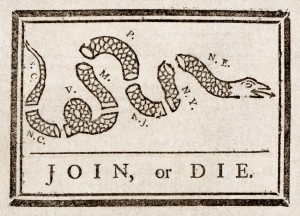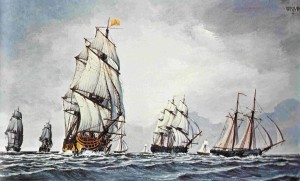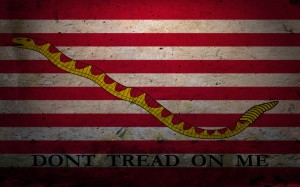We all know that flag and have a good idea of when and why it was designed; so here is a little historical info for those interested. The Gadsden flag is the classic flag with a yellow field depicted a coiled rattlesnake ready to strike. The flag was named after the American Revolutionary War general Christopher Gadsden, who designed it in 1775 during the revolution. It was also used by Continental Marines as an early motto flag and in modern times has often come to symbolize libertarianism or the Tea Party movement.
Both the timber rattlesnake and diamondback rattlesnake populated the geographical regions of the original thirteen colonies. The use of these snakes as a symbol for the American colonies can be traced back at least as far as the publications of Benjamin Franklin in the Pennsylvania Gazette. As the British had been sending convicted criminals to people the American colonies, Franklin satirically suggested the colonies thank the British by sending back rattlesnakes to England.
Franklin published his famous woodcut of a snake cut into eight sections in 1754 during the French and Indian War. The woodcut represented the colonies with New England as the head and South Carolina as the tail; representative of their geographical locations along to coast. Under the snake was the message “Join, or die” and is popularized as the first political cartoon published in a New World newspaper.
As the American began to sever thoughts of vassalage to England in favor of their own communities and liberty they began to identify themselves with icons unique to the American colonies such as rattlesnakes, bald eagles, and the American Indian. As the American Revolution took shape, the snake became more common as a symbol for the colonies. In 1775 Franklin suggested that the rattlesnake was a good symbol for the American spirit:
I recollected that her eye excelled in brightness, that of any other animal, and that she has no eye-lids—She may therefore be esteemed an emblem of vigilance.—She never begins an attack, nor, when once engaged, ever surrenders: She is therefore an emblem of magnanimity and true courage.—As if anxious to prevent all pretensions of quarreling with her, the weapons with which nature has furnished her, she conceals in the roof of her mouth, so that, to those who are unacquainted with her, she appears to be a most defenseless animal; and even when those weapons are shown and extended for her defense, they appear weak and contemptible; but their wounds however small, are decisive and fatal:—Conscious of this, she never wounds till she has generously given notice, even to her enemy, and cautioned him against the danger of stepping on her.—Was I wrong, Sir, in thinking this a strong picture of the temper and conduct of America?
In 1775 the United States Navy was established by General George Washington in his role of Commander in Chief of all the Continental Forces. The Second Continental Congress authorized the mustering of five companies of Marines to accompany the Navy on their first mission to intercept British ships carrying war supplies. The first mention of Gadsden’s flag symbolism was used by the Marines enlisted in Philadelphia where they carried drums painted yellow, depicting a coiled rattlesnake with thirteen rattles and the motto “Don’t Tread on Me.” Gadsden was one of seven members of the Marine Committee who outfitted the first naval mission. Before departure Gadsden presented the newly appointed command in chief of the Navy, Commodore Hopkins; a yellow rattlesnake flag as the distinctive personal standard of his flagship. Gadsden also presented a copy of the flag to the Congress of South Carolina in1776:
Col. Gadsden presented to the Congress an elegant standard, such as is to be used by the commander in chief of the American Navy; being a yellow field, with a lively representation of a rattlesnake in the middle in the attitude of going to strike and these words underneath, “Don’t tread on me.”
Considered one of the first flags of the United States, the flag was later replaced by the Stars and Stripes, or “Old Glory” flag. Since the Revolution the flag has seen times of reintroduction as a symbol of American patriotism and civil liberties. It has often been flown during times of dissatisfaction and disagreement with governmental actions and directions.
The First Navy Jack was not directly related to the Gadsden flag and traditionally has been used by the United States Navy since its beginnings. The Snake on stripes was in a book of flags by Admiral Preble, but there is no letter currently known authorizing its design or dictating its origins. It is likely that Snake on stripes was never flown during the Revolution, according to Preble.
Jon





Leave a Reply